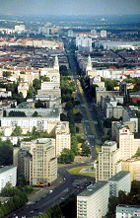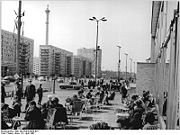
Karl-Marx-Allee
Encyclopedia


Boulevard
A Boulevard is type of road, usually a wide, multi-lane arterial thoroughfare, divided with a median down the centre, and roadways along each side designed as slow travel and parking lanes and for bicycle and pedestrian usage, often with an above-average quality of landscaping and scenery...
built by the GDR between 1952 and 1960 in Berlin
Berlin
Berlin is the capital city of Germany and is one of the 16 states of Germany. With a population of 3.45 million people, Berlin is Germany's largest city. It is the second most populous city proper and the seventh most populous urban area in the European Union...
Friedrichshain
Friedrichshain
Friedrichshain is a part of Berlin's borough of Friedrichshain-Kreuzberg, and like Kreuzberg across the river it has its own distinct character, with the result that the new double name is hardly ever used outside government administration. From its creation in 1920 until Berlin's 2001...
and Mitte
Mitte
Mitte is the first and most central borough of Berlin. It was created in Berlin's 2001 administrative reform by the merger of the former districts of Mitte proper, Tiergarten and Wedding; the resulting borough retained the name Mitte. It is one of the two boroughs which comprises former West and...
. Today the boulevard is named after Karl Marx
Karl Marx
Karl Heinrich Marx was a German philosopher, economist, sociologist, historian, journalist, and revolutionary socialist. His ideas played a significant role in the development of social science and the socialist political movement...
.
The boulevard was named Stalinallee between 1949 and 1961 (previously Große Frankfurter Straße), and was a flagship building project of East Germany's reconstruction programme after World War II
World War II
World War II, or the Second World War , was a global conflict lasting from 1939 to 1945, involving most of the world's nations—including all of the great powers—eventually forming two opposing military alliances: the Allies and the Axis...
. It was designed by the architects Hermann Henselmann
Hermann Henselmann
Hermann Henselmann was a German architect most famous for his buildings constructed in East Germany during the 1950s and 60s.-Early years:...
, Hartmann, Hopp, Leucht, Paulick and Souradny to contain spacious and luxurious apartments for plain workers, as well as shops, restaurants, cafés, a tourist hotel and an enormous cinema (the International).
The avenue, which is 89 m wide and nearly 2 km long, is lined with monumental eight-storey buildings designed in the so-called wedding-cake style
Wedding-cake style
In architecture, a "wedding-cake style" is an informal reference to buildings with many distinct tiers, each set back from the one below, resulting in a shape like a wedding cake, that are richly ornamented with classicising detail, as if made in sugar icing....
, the socialist classicism of the Soviet Union
Soviet Union
The Soviet Union , officially the Union of Soviet Socialist Republics , was a constitutionally socialist state that existed in Eurasia between 1922 and 1991....
. At each end are dual towers at Frankfurter Tor and Strausberger Platz designed by Hermann Henselmann
Hermann Henselmann
Hermann Henselmann was a German architect most famous for his buildings constructed in East Germany during the 1950s and 60s.-Early years:...
. The buildings differ in the revetments of the facades which contain often equally, traditional Berlin motifs by Karl Friedrich Schinkel
Karl Friedrich Schinkel
Karl Friedrich Schinkel was a Prussian architect, city planner, and painter who also designed furniture and stage sets. Schinkel was one of the most prominent architects of Germany and designed both neoclassical and neogothic buildings.-Biography:Schinkel was born in Neuruppin, Margraviate of...
. Most of the buildings are covered by architectural ceramics.
On June 17, 1953 the Stalinallee became the focus of a worker uprising which endangered the young state's existence. Builders and construction workers demonstrated against the communist government, leading to a national uprising. The rebellion was quashed with Soviet tanks and troops, resulting in the loss of at least 125 lives.
Later the street was used for East Germany's annual May Day
May Day
May Day on May 1 is an ancient northern hemisphere spring festival and usually a public holiday; it is also a traditional spring holiday in many cultures....
parade, featuring thousands of soldiers along with tanks and other military vehicles to showcase the power and the glory of the communist government.
De-Stalinization
De-Stalinization
De-Stalinization refers to the process of eliminating the cult of personality, Stalinist political system and the Gulag labour-camp system created by Soviet leader Joseph Stalin. Stalin was succeeded by a collective leadership after his death in March 1953...
led to the renaming of the street, after the uncontroversial (in the GDR) founder of Marxism
Marxism
Marxism is an economic and sociopolitical worldview and method of socioeconomic inquiry that centers upon a materialist interpretation of history, a dialectical view of social change, and an analysis and critique of the development of capitalism. Marxism was pioneered in the early to mid 19th...
, in late 1961. Since the collapse of Eastern European communism in 1989/1990, renaming the street back to its prewar name Große Frankfurter Straße has periodically been discussed, so far without conclusive results.
The boulevard later found favour with postmodernists
Postmodern architecture
Postmodern architecture began as an international style the first examples of which are generally cited as being from the 1950s, but did not become a movement until the late 1970s and continues to influence present-day architecture...
, with Philip Johnson
Philip Johnson
Philip Cortelyou Johnson was an influential American architect.In 1930, he founded the Department of Architecture and Design at the Museum of Modern Art in New York City, and later , as a trustee, he was awarded an American Institute of Architects Gold Medal and the first Pritzker Architecture...
describing it as 'true city planning on the grand scale', while Aldo Rossi
Aldo Rossi
Aldo Rossi was an Italian architect and designer who accomplished the unusual feat of achieving international recognition in four distinct areas: theory, drawing, architecture and product design.-Early life:...
called it 'Europe's last great street.' Since German reunification
German reunification
German reunification was the process in 1990 in which the German Democratic Republic joined the Federal Republic of Germany , and when Berlin reunited into a single city, as provided by its then Grundgesetz constitution Article 23. The start of this process is commonly referred by Germans as die...
most of the buildings, including the two towers, have been restored.
Stalin's Bathroom
In February 2009 an anonymous author edited the article "Karl-Marx-Allee" in the German language edition of Wikipedia, claiming that during the time of the GDR the road had garnered the nickname "Stalin's bathroom" due to the buildings' tiled facades. Subsequently, several media outlets reiterated this claim. No alternative verification for the term was given, making it a self-referential claim.After a letter written in the Berliner Zeitung
Berliner Zeitung
The Berliner Zeitung, founded in 1945, is a German center-left daily newspaper based in Berlin, published by Berliner Verlag. It is the only East German paper to achieve national prominence since unification. In 2003, the Berliner was Berlin's largest subscription newspaper—the weekend...
doubting that the term "Stalin's bathroom" had actually been in common use during the GDR period Andreas Kopietz, a journalist at the newspaper, published an article admitting he had invented the phrase and was the original anonymous Wikipedia editor, allowing the record to be set straight.
See also
- Stalinist architectureStalinist architectureStalinist architecture , also referred to as Stalinist Gothic, or Socialist Classicism, is a term given to architecture of the Soviet Union between 1933, when Boris Iofan's draft for Palace of the Soviets was officially approved, and 1955, when Nikita Khrushchev condemned "excesses" of the past...
- Seven Sisters (Moscow)Seven Sisters (Moscow)The "Seven Sisters" is the English name given to a group of Moscow skyscrapers designed in the Stalinist style. Muscovites call them Vysotki or Stalinskie Vysotki , " high-rises"...
- The Strasse der Pariser Kommune (street of the Paris CommuneParis CommuneThe Paris Commune was a government that briefly ruled Paris from March 18 to May 28, 1871. It existed before the split between anarchists and Marxists had taken place, and it is hailed by both groups as the first assumption of power by the working class during the Industrial Revolution...
) connects with Karl-Marx-Allee
External links
- Homepage (in German)

